Icefall
Harmless

Posts: 8
Registered: 7-1-2015
Member Is Offline
Mood: No Mood
|
|
Picric acid from phenol - need help
Hello everybody,
I am new to this forum but I have been reading and using information from it for quite a long time. I have been into energetics for a year or so, so
far I have only done simple syntheses like HMTD, nitrogen triiodide, AP, nitrocellulose, KClO3, black powder etc. Recently I have decided to make
something more powerful and storable (also a suitable base explosive) so I tried to synthesise picric acid from phenol following the powerlabs method
(with some adjustments), but I failed, and I’d like to ask where.
(All chemicals are of analytical grade, which, I believe, should be pretty much sufficient) Because of its extremely annoying smell, I store my phenol
outside (~0 to -10 °C) therefore it is a nice crystalline-white powder. Other chemicals I used were of room-temperature.
I weighed 25grams of phenol, and added it to 38mLs of 96% concentrated H2SO4. The mixture turned to a slightly brown(ish) color, and it was put into a
boiling water bath for 30 minutes. It was removed from the bath and a dark brown solution, with a slight tint of orange was obtained. For the
nitration I decided not to use a bath, but instead only slowly add the nitric acid while phenol-H2SO4 mixture was still hot (80-100°C). I thought
that the heat generated by nitration would suffice to keep the temperature at 80+°C, so I didn't even use a thermometer (now to think of it, a
foolish decision  ). I took the still hot solution outside, to a place where
constant wind was blowing and started adding 47mLs of 65% HNO3(slightly lower concentration than required, but it’s the best I could get my hands
on) dropwise. There was a big amount of brown fumes produced, as well as white vapour (mostly evaporated water I believe) and the mixture started
foaming a bit, but I think it was fine as no runaway occurred (which was the result of my first attempt with TNP, but that’s a different story).
After each 2 - 4ml addition the mixture was stirred with a glass rod and swirled for 20-30s. With the last 10mLs of HNO3, there were not as many fumes
produced and the mixture was a lot "calmer" but still it felt quite hot (90+°C I guess). After the final addition it was swirled for a few minutes
longer and a very dark red colour solution was obtained. It was then put into a 90°C water bath where heating was applied for 1,5 hours. The colour
changed to black during this time. After heating, there were 500mLs of ice-cold distilled water added, and to my surprise the solution didn't change
colour to the typical picric-yellow(like orange juice), but instead to red with dark-orange precipitate floating in it. Here's a photo of how it
looked like (sorry for the shitty quality, it was taken in the afternoon with my phone camera) - ). I took the still hot solution outside, to a place where
constant wind was blowing and started adding 47mLs of 65% HNO3(slightly lower concentration than required, but it’s the best I could get my hands
on) dropwise. There was a big amount of brown fumes produced, as well as white vapour (mostly evaporated water I believe) and the mixture started
foaming a bit, but I think it was fine as no runaway occurred (which was the result of my first attempt with TNP, but that’s a different story).
After each 2 - 4ml addition the mixture was stirred with a glass rod and swirled for 20-30s. With the last 10mLs of HNO3, there were not as many fumes
produced and the mixture was a lot "calmer" but still it felt quite hot (90+°C I guess). After the final addition it was swirled for a few minutes
longer and a very dark red colour solution was obtained. It was then put into a 90°C water bath where heating was applied for 1,5 hours. The colour
changed to black during this time. After heating, there were 500mLs of ice-cold distilled water added, and to my surprise the solution didn't change
colour to the typical picric-yellow(like orange juice), but instead to red with dark-orange precipitate floating in it. Here's a photo of how it
looked like (sorry for the shitty quality, it was taken in the afternoon with my phone camera) -

I left the solution overnight at 9°C to cool-down. Then I left it outside to cool-down to 0°C - It changed colour to bright red-

After filtering the crystals and removing excess acids with cold d-water, all I was left with was an evil-looking orangered mess -

And the question is - What are the crystals made of? Which step did I fail at?
I thought I just hadn't nitrated the mixture well enough and had only crude dinitrophenol. I decided to quickly try to further nitrate it, just to see
if it works and to check whether it really is DNP. I added some of the crystals into concentrated H2SO4 (no measuring, just estimating). It formed a
black solution with some of the crystals undissolved. Into this mixture I added approximately the same volume of 1:1 HNO3-H2SO4, swirled for a while
and then dumped into cold d-water. Now, the solution had a much better (nearly picric yellow – which is fine considering neither heating nor
measuring was done) colour, and the filtered crystals seem to be a mixture of DNP and TNP.

Note the orange colored crystals (before nitration) near top of the beaker

Am I right to assume that what I need to do, is to add more H2SO4 at the very beginning and then add at least twice the amount of HNO3? It seems
strange to me to use only 38mLs H2SO4 and 47mLs HNO3 as other methods (even with ASA as precursor) use much, much more...Or is there something else
except for a failed nitration? Next time I’m planning to try the method from Praxis des organischen Chemikers – 20g phenol, 45mLs H2SO4, 100mLs
HNO3, oil bath of room temp during nitration, then heated to 112°C.
Thanks in advance, and sorry for my bad English 
[Edited on 8-1-2015 by Icefall]
|
|
|
Hennig Brand
International Hazard
    
Posts: 1284
Registered: 7-6-2009
Member Is Offline
Mood: No Mood
|
|
Try this it works:
Quote: Originally posted by a_bab  | Try this one. It's a russian method for labs.
94 grams of phenol (1 mole) should be heated at 100 degrees C and add 300 g of H2SO4 monohydrate under agitation. Heat the mix for 1 hour at 100-110
degrees C, then cool it down to 0 degrees C. Under exterior cooling (less than 0 degrees C) and energical agitation, add drop by drop a mix formed of
220 grams (3,5 moles) of HNO3 of 98 % and 220 grams of H2SO4 monohydrate. After all the sulfonitric mix has been added, left the mix at the room
temperature overnight and then heat it at max. 45 degrees C, for an hour with agitation. Because the reaction is not finished at 45 degrees, 50 ml
from the reaction mass is taken out and heated on a sand bath at 110-125 degrees C. In the heated mass the rest of the mix is added drop by drop under
energycal agitation. Afterwards is should kept at 120 degrees and some water should be added until the H2SO4 will be 40 % concentrated (about 700 ml
of water). If the reaction was conducted in good conditions a small quantity of NO2 will be released. TNP which will crystalize on cooling and it's
not soluble in H2SO4 40 % will be filtered, and washed with cold water. The total amount of TNP obtained it'll be around 210 grams.
Nevermind the mistakes as I translated this on the fly. |
This was taken from the first page of the very lengthy thread on picric acid found here:
http://www.sciencemadness.org/talk/viewthread.php?tid=389#pi...
There is a huge amount of information on picric acid in various places on this forum, but you may need to dig a little.
"A risk-free world is a very dull world, one from which we are apt to learn little of consequence." -Geerat Vermeij
|
|
|
Icefall
Harmless

Posts: 8
Registered: 7-1-2015
Member Is Offline
Mood: No Mood
|
|
Yes, I have read the first 7-8 pages of that article, I know a lot about Rosco's findings about solubility (I used a few drops of HCl during
precipitation phase) and temperature control during nitration etc. but this one seems pretty impossible to me as it uses 98% HNO3
I have also read that one can use less concentrated acid as well, but he has to use more H2SO4 then. However, what I don't know are the proportions,
as one cannot use stoichiometry with nitrations and this is a pretty distinct nitration (via phenol-4-sulphonic and disulphonic acids)
It seems like I have to read through the thread more thoroughly 
For now, I think I'll stick with the German method, as it seems easier (ofc with lower yields), and if it won't work I'll try this one 
[Edited on 8-1-2015 by Icefall]
|
|
|
Hennig Brand
International Hazard
    
Posts: 1284
Registered: 7-6-2009
Member Is Offline
Mood: No Mood
|
|
Yes, the quantities used will be in excess to a certain extent, but you definitely can use stoichiometry. Review the literature and find a trusted
synthesis, determine or just read (if included) the mole or mass fractions of acids and material to be nitrated. Different strengths of acids can
often be used to give the same nitration mixture composition. You may have to use an excess of nitration mixture or an excess of one of the nitration
mixture components in order to satisfy the requirements of the particular nitration such as getting the proportion of water at the start of the
reaction and at the end low enough.
"A risk-free world is a very dull world, one from which we are apt to learn little of consequence." -Geerat Vermeij
|
|
|
roXefeller
Hazard to Others
  
Posts: 463
Registered: 9-9-2013
Location: 13 Colonies
Member Is Offline
Mood: 220 221 whatever it takes
|
|
Stoich is useful for determining the excess of reagents. It gives you a way of objectively quantifying excess such as using 1.5x stoich quantities.
One other deviation from Rosco's directions is the temperature during the third nitration phase when moving from DNP to TNP that is the last third of
the HNO3 additions. He suggests an accurate temp control around 114C. The final nitro group requires the higher energy level.
Another point to mention, the initial sulfonation of the phenol takes time and can't be rushed. You should be able to see crystals form when it cools
down enough to the point where the solution freezes into a frozen slushy mass.
But all in all TNP can take practice and observation.
|
|
|
Icefall
Harmless

Posts: 8
Registered: 7-1-2015
Member Is Offline
Mood: No Mood
|
|
Thx
So, according to stoichiometry, one needs 3mol of HNO3 for every 1mol of phenol. 25grams equals 0,2657mol, so the amount of HNO3 needed for
tri-nitration would be 0,797mol. This means 50,22grams of 100% HNO3 and 77,26g of 65% HNO3, which at the density of 1,40 equals 55,15mLs of acid.
Well, it seems I should have done these calculations before actually trying synthesis  Never mind, this time I'll use more than twice as much HNO3 as well as more H2SO4. The mixture will also be heated with an oil bath to 115
centigrades after adding HNO3. Never mind, this time I'll use more than twice as much HNO3 as well as more H2SO4. The mixture will also be heated with an oil bath to 115
centigrades after adding HNO3.
There is one more thing I'd like to ask - Is it possible to mix it vice-versa and add the phenol-sulphonic acid to nitric acid? There will be an
over-abundance of NO2 ions (especially in the beginning) and the nitration should proceed more thoroughly
|
|
|
CuReUS
National Hazard
   
Posts: 928
Registered: 9-9-2014
Member Is Offline
Mood: No Mood
|
|
see this video,its the best I have seen for making picric acid
https://www.youtube.com/watch?v=35iwjK5PQts
|
|
|
Praxichys
International Hazard
    
Posts: 1063
Registered: 31-7-2013
Location: Detroit, Michigan, USA
Member Is Offline
Mood: Coprecipitated
|
|
It looks like your temperature was too low, acid concentration too low, or the nitration time was too short. You seem to have a lot of DNP, which is
very red, more soluble, and has a lower melting point than TNP. Try taking a melting point of your product. Try using 100% HNO3 or a nitrate salt next
time.
Some images for reference:
Before dilution / After dilution / After cooling / Solidified DNP stuck to bottom after filtering
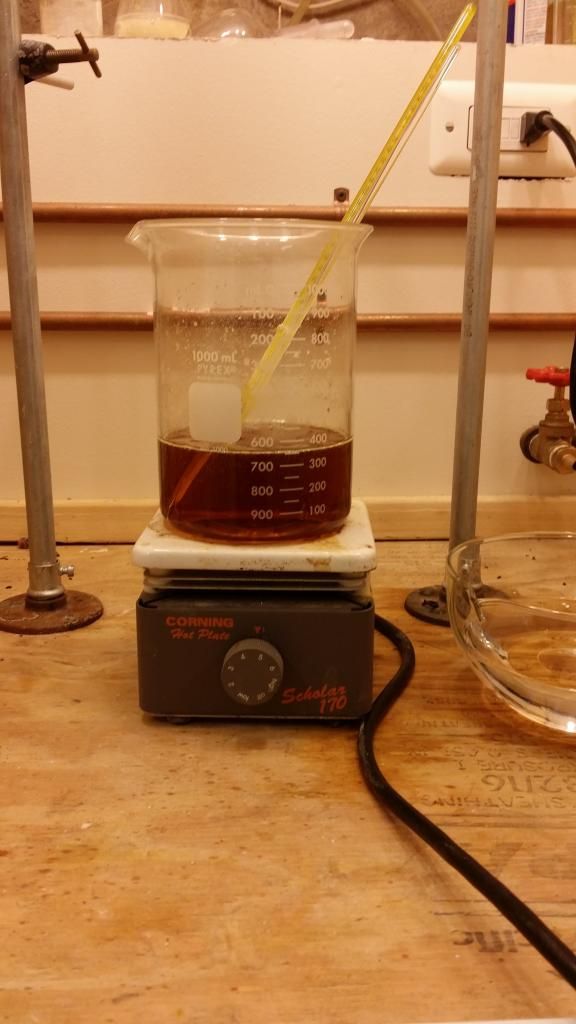 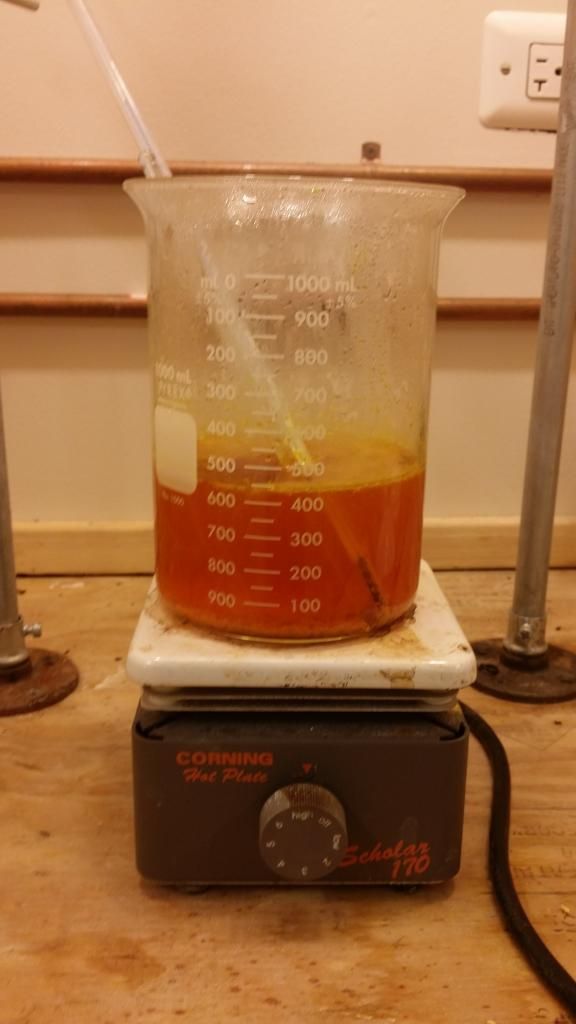 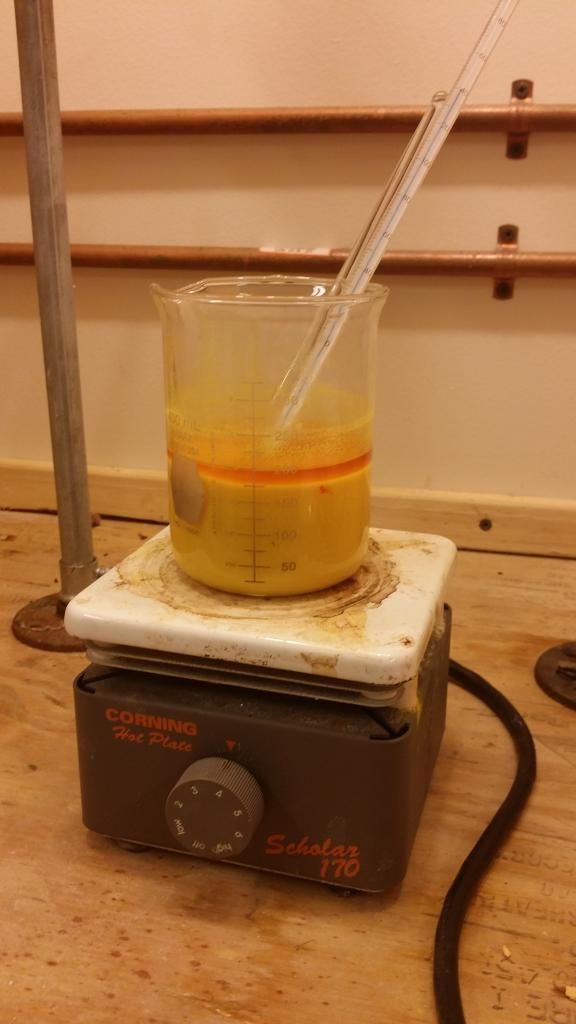 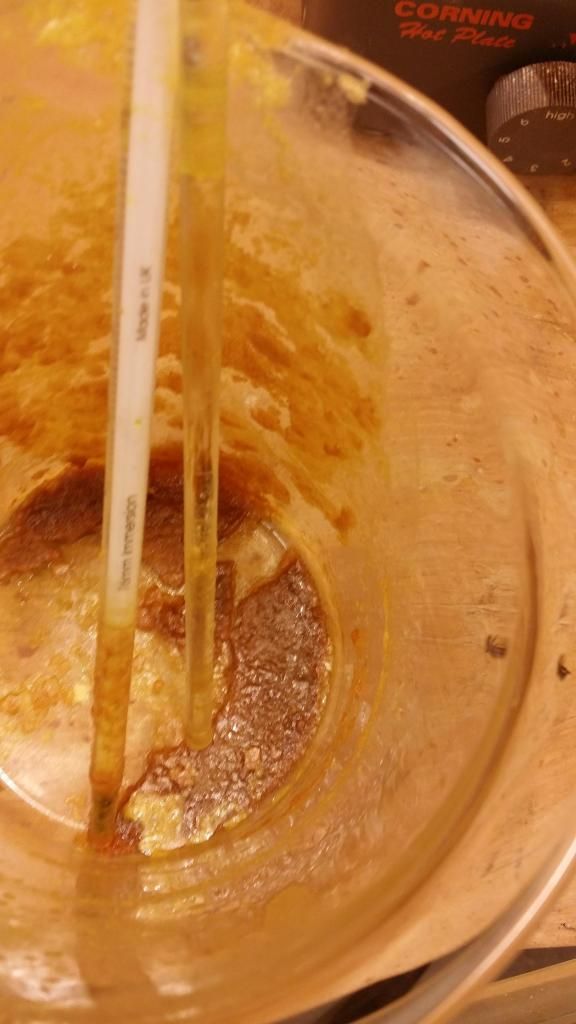
Filter cake
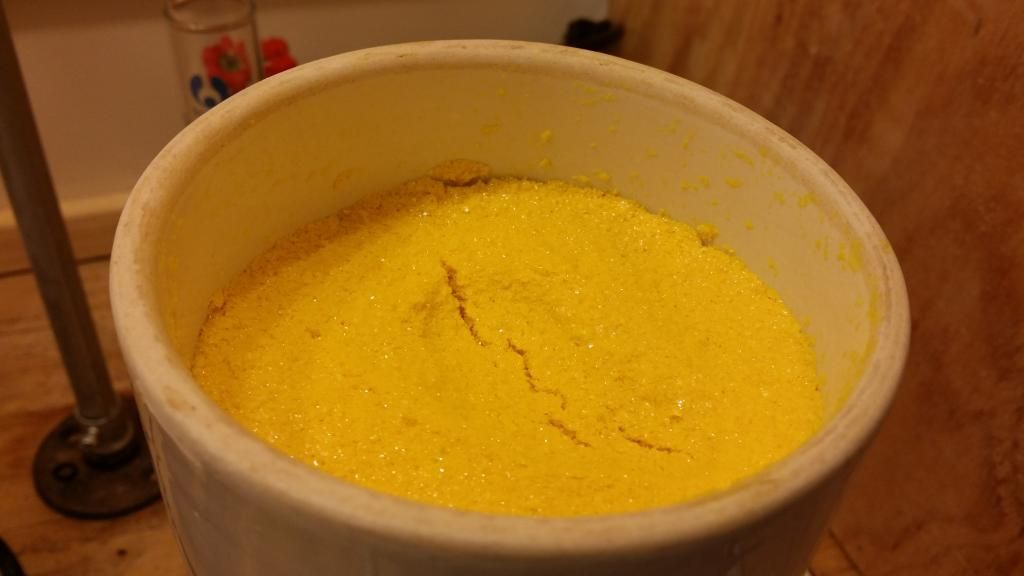
This was a one-pot from acetylsalicylic acid, starting with H2SO4 hydrolysis/sulfonation followed by nitration using KNO3. Using KNO3 instead of HNO3
keeps the acid concentration high and gives better yield. Once all the nitrate has been added, the mix needs to sit at 120C for about 30 minutes to
fully nitrate.
It is then cooled and water added slowly to precipitate the product. The mix is then reheated, which melts the DNP in the bottom (~108C) and causes it
to stick there. On cooling again, the TNP can be filtered with most of the DNP left stuck to the bottom of the beaker. (see photo)
Recrystallization is necessary. Pure TNP is a paler yellow than the raw product shown in the filter cake.
This procedure is an adaptation from the one on LambdaSyn.
|
|
|
Bert
Super Administrator
        
Posts: 2821
Registered: 12-3-2004
Member Is Offline
Mood: " I think we are all going to die. I think that love is an illusion. We are flawed, my darling".
|
|
Watching the NOx coming off the reaction in the Vietnamese video, done indoors and without a hood made me cringe.
Apparently, he had a fan blowing past the reaction. And lived long enough to edit the video-
Rapopart’s Rules for critical commentary:
1. Attempt to re-express your target’s position so clearly, vividly and fairly that your target says: “Thanks, I wish I’d thought of putting it
that way.”
2. List any points of agreement (especially if they are not matters of general or widespread agreement).
3. Mention anything you have learned from your target.
4. Only then are you permitted to say so much as a word of rebuttal or criticism.
Anatol Rapoport was a Russian-born American mathematical psychologist (1911-2007).
|
|
|
Icefall
Harmless

Posts: 8
Registered: 7-1-2015
Member Is Offline
Mood: No Mood
|
|
Thanks for replies, the pictures look pretty good.
I think the problem was either with temperature (too high which caused the phenol to oxidise), or, most likely with using a very small amount of
nitric acid which is even smaller than the amount needed theoretically based on stoichiometry. Not to speak of the fact that the volume of acid used
in practice needs to be larger than the theoretical volume...
The method I'm going to try tomorrow is also from LambdaSyn (which is pretty much copied from Praxis des organischen Chemikers), and uses more than
twice as much HNO3 (of 65-70% concentration) than the one from powerlabs (68%). This time, I'll also keep control of the temperature, not allowing it
to rise above 125°C during nitration, and then, after adding HNO3, heating the mixture to 100°C with an oil bath for one hour followed by 115-120°C
for another 30 minutes.
As for the nitrate salt, it is another option which I'll try if I fail at this method (can't get my hands on 100% HNO3). So far I haven't seen a
"recipe" which uses phenol (only ASA), NO3 salt and H2SO4, but I'll look better into it if I fail with HNO3
I'll post the results tomorrow 
[Edited on 9-1-2015 by Icefall]
|
|
|
Bert
Super Administrator
        
Posts: 2821
Registered: 12-3-2004
Member Is Offline
Mood: " I think we are all going to die. I think that love is an illusion. We are flawed, my darling".
|
|
A long time back, I tried several of "powerlabs" procedures. They sometimes worked. But never were very well optimized, I came to find.
Experienced workers will apply stoichiometry, but also research the adjustments to theory that give a good compromise between workable consistency,
economy of ingredients (depends on what reagents are available, price!) and yield.
Quote: Originally posted by Rosco Bodine  | The most recent synthesis is one where some temperatures were closely watched and refined , and the nitration went very smoothly with absolutely no
surging nor red fume production , resulting in an exceptionally pure end product in 90% yield based on ASA . So the conditions are a good baseline
reference for any fine tuning of the process in efforts to get a little better efficiency . I believe it may be ultimately possible to get yields up
around 98% using some adjustments , but a 90% yield process provides a good place to start .
The synthesis followed my rule of thumb proportions which have always produced a good result , for each 1 gram purified ASA , 4 ml 92% H2SO4 , 1.8
grams purified NaNO3 .
In a 1 liter Erlenmeyer 24/40 flask was placed a 10 X 35 mm stirbar and 750 ml of
92% H2SO4 heated with stirring to 80 C .
187.5 grams of purified ASA was added in small portions as fast as it would dissolve in the stirred mixture over the course of 45 minutes , the
temperature gradually rising to about 105 C by the heat of reaction as the ASA dissolved . The flask was loosely stoppered with a hollow glass 24/40
stopper . Supplemental heating gradually raised the temperature to 118 C at the end of 90 minutes and the heating was discontinued . After standing
overnight the sulfonated ASA mixture had cooled and solidified to a dark colored transparent gel filled with small tan cubical? crystals of sulfonated
ASA . The mixture had to be reheated to 115 C to melt and with stirring redissolve so the mixture could be poured into the nitration flask .
Into a 4,000 ml Erlenmeyer flask was placed a heavy ( 62 gram ) 3 inch oval stirbar , and was set upon an old Type 1000 Thermolyne 7.5 X 7.5 stirrer
hotplate . Dry , sifted free of lumps , NaNO3 , 339 grams total was divided into three equal 113 gram portions in preparation for the nitration and
kept in sealed containers .
The hot sulfonated ASA mixture was poured into the 4L Erlenmeyer , the 900 ml of hot liquid not quite deep enough to completely cover the stirbar .
An 18 inch thermometer , 260 C 75 mm immersion , was leaned diagonally in the flask with its tip sitting in the curved bottom outer edge inside the
flask . A 4 inch flexible ventilation duct mounted in an extension ring was positioned next to the flask opening for removal of any fumes by the
remotely located blower whose intake air is drawn through the 4 inch hose and discharged outdoors . A second larger fan was situated next to the low
workbench to pull a gentle draft in the same general direction as the higher velocity intake adjacent the opening of the flask . These sorts of
precautions are essential for safely conducting a nitration on a molar scale . The nitration was conducted outdoors in an area shaded from direct
sunlight .
The stirrer was started and run just below the speed where splashing of the shallow liquid occurred , with portions of nitrate begun with the mixture
at 95 C ,
the decarboxylation foaming occurring instantly on contact from the first addition of nitrate . The additions were made steadily in portions using a
teaspoon ,
adding the nitrate in heavy sprinkles into the vortex , the reaction temperature rising and maintained in the range of 100 to 103 C by regulating the
rate of additions of the solid nitrate . The effervescence of CO2 from decarboxylation
occurred freely with no persistent foaming through the end of the addition of the first of the three portions of nitrate , and midway into the second
portion at 1 hour from the beginning of the nitration . At this midpoint , the effervescence becomes more sluggish and the viscosity of the mixture
is increased , the foaming from decarboxylation causes a volume increase for the mixture , and the additions must be slowed considerably . At the end
of the addition of the second portion , the heat of reaction alone is insufficient and very gentle supplemental heating is added to maintain 103 C .
About 15 grams into the final portion of nitrate , the time from the beginning of nitration will be 1 hour 45 minutes and some picric acid will begin
to precipitate in the thickening mixture , greatly slowing the remaining additions . The stirring speed is increased and the heating is raised to 106
C by 2 hours from the beginning of nitration . The remaining nitrate additions go very slowly and will require as much time as all of the nitrate
previously added . The temperature is very gradually allowed to increase over the remaining additions of nitrate , the following observations were
made for
reference concerning the elapsed times from the beginning of nitration , and the total amount of the third portion of nitrate having been added .
@ 2 hours 15 minutes , 30 grams ,
107-108 C
@ 2 hours 30 minutes , 40 grams ,
109 C
@ 2 hours 45 minutes , 45 grams ,
111 C
@ 3 hours , 55 grams , 113-114 C
@ 3 hours 10 minutes , 60 grams , 114 C
At this point the mixture has become a very thick slurry and additions are suspended for a time . There is an accumulation of solids upon the walls
of the flask and the thermometer is used to scrape the material into the vortex so the mixing can be accomplished . This manual assistance is
required several times during the course of the remaining nitration . Close temperature control is essential to limit temperature to 114 C , as there
are indications of an induction point for decomposition at about 116 C .
@ 3 hours 30 minutes , nitrate additions cautiously resumed , 113 C reaction temperature
@ 3 hours 45 minutes , 70 grams , 112 C
@ 4 hours , 85 grams , 112 C
@ 4 hours 30 minutes , 113 grams completion of addition 110 C , Supplemental heating very slightly reduced , reaction allowed to continue
@ 5 hours , slowly finishing reaction has cooled to 100 C and reaction appears complete , the temperature is subsiding
and the mixture is thinning as the temperature falls . Supplemental heating discontinued completely .
@ 5 hours 10 minutes , 97 C , mixture is now much thinner and is a free stirring smooth slurry with no foam whatsoever ,
a suspension of fine yellow reflective crystals of picric aicd suspended in a water clear colorless supernatant liquid of spent acid and bisulfate in
solution
@ 5 hours 20 minutes , 92 C , cautious and gradual dilution of the stirred mixture was begun by streaming water from a wash bottle onto the inner
walls of the flask and allowing the stirred mixture to be gradually diluted , limiting the temperature rise to 100 C , a total of about 1 liter of
water was added . The dilution was accompanied by a fair amount of red fumes being evolved , believed to be the result of decomposition of
nitrosylsulfuric aicd present in the spent nitration mixture .
The total volume of the diluted mixture was at the 2,000 ml graduation on the flask .
@ 6 hours , 74 C , ice is added to bring volume of diluted mixture to 2800 ml ,
and to speed cooling .
@ 6 hours 15 minutes , 23 C
Flask is placed in refrigerator to complete the precipitation .
The crude picric acid is filtered and blottered , and the still damp crystals are redissolved in 5200 ml boiling distilled water . On slow cooling ,
excellent crystals are formed , which after filtering and drying , are obtained 198 grams from the first crystallization , 83% yield based upon ASA ,
of exceptional quality picric acid .
An additional second crop of crystals ,
16 grams is obtained by boiling down the filtered liquid from the first crystallization to a volume of 1300 ml , and allowing to cool .
Yet a third crop of maybe 2 grams can be obtained by concentrating to 300 ml and cooling .
There was absolutely no dark colored impurity produced to tint the solutions or to precipitate and contaminate the product . The picric acid produced
was
absolutely free from any contamination byproducts . |
Rapopart’s Rules for critical commentary:
1. Attempt to re-express your target’s position so clearly, vividly and fairly that your target says: “Thanks, I wish I’d thought of putting it
that way.”
2. List any points of agreement (especially if they are not matters of general or widespread agreement).
3. Mention anything you have learned from your target.
4. Only then are you permitted to say so much as a word of rebuttal or criticism.
Anatol Rapoport was a Russian-born American mathematical psychologist (1911-2007).
|
|
|
Bot0nist
International Hazard
    
Posts: 1559
Registered: 15-2-2011
Location: Right behind you.
Member Is Offline
Mood: Streching my cotyledons.
|
|
I have had that page bookmarked for years. I have yet to discover a more optimized and repeatable ASA -> TNP writeup anywhere. And variations or
substitutions at all, only serve to reduce yields and/or purity, IMO. Hennig is right about digging. There are so many hard to find gems. Like the
above, and Quicksilver's ETN writeups and crystallization experiments...
If you have asprin, and want to attempt a tried and true TNP procedure, try the above.
P.S.
Heed Hennig and Rosco's advice, and search for their conversations on TNP and basic lead picrate. They proved very educational and in depth, to me.
[Edited on 10-1-2015 by Bot0nist]
U.T.F.S.E. and learn the joys of autodidacticism!
Don't judge each day only by the harvest you reap, but also by the seeds you sow.
|
|
|
Icefall
Harmless

Posts: 8
Registered: 7-1-2015
Member Is Offline
Mood: No Mood
|
|
Success!
Hello again,
The synthesis was pretty good now  This time, I added phenol-sulphonic acid to
nitric acid and not vice versa, like most "recipes" say. I also used a room-temperature oil bath during nitration. The phenol-sulfonic acid had ~80°C
and the nitric acid had room temp. After first 25mLs the mixture only turned red but no vigorous reaction happened. I stirred the mixture very
thoroughly, and I was expecting a runaway nitration to occur. I added another 25mLs, which caused the reaction to start, with fuming and simmering. By
this time, I knew that everything is going well because the nitration seemed much smoother and calmer than the latter. There wasn't any foam and it
had a beautiful deep-red colour. I slowly added the rest of phenol-sulphonic mix with occasional stirring, a few mLs at a time, just enough to keep
the reaction running. The temperature didn't rise above 100°C during the whole reaction. After addition, the reaction vessel was completely filled
with TNP crystals (yay!), and being heated to 115°C a large amount, again, of NO2 gas was produced, which could barely escape through the thick layer
of crystals (stirring was necessary). I didn't heat it for a long time though, because I didn't place my hotplate on a spot with good ventilation
(outside ofc) which affected my yield significantly. I diluted the mix with ~300mLs of d-water and the mixture turned to a nice picric-yellow colour. This time, I added phenol-sulphonic acid to
nitric acid and not vice versa, like most "recipes" say. I also used a room-temperature oil bath during nitration. The phenol-sulfonic acid had ~80°C
and the nitric acid had room temp. After first 25mLs the mixture only turned red but no vigorous reaction happened. I stirred the mixture very
thoroughly, and I was expecting a runaway nitration to occur. I added another 25mLs, which caused the reaction to start, with fuming and simmering. By
this time, I knew that everything is going well because the nitration seemed much smoother and calmer than the latter. There wasn't any foam and it
had a beautiful deep-red colour. I slowly added the rest of phenol-sulphonic mix with occasional stirring, a few mLs at a time, just enough to keep
the reaction running. The temperature didn't rise above 100°C during the whole reaction. After addition, the reaction vessel was completely filled
with TNP crystals (yay!), and being heated to 115°C a large amount, again, of NO2 gas was produced, which could barely escape through the thick layer
of crystals (stirring was necessary). I didn't heat it for a long time though, because I didn't place my hotplate on a spot with good ventilation
(outside ofc) which affected my yield significantly. I diluted the mix with ~300mLs of d-water and the mixture turned to a nice picric-yellow colour.
I filtered the crystals, purified them with 1L of cold d-water, dissolved them in 250mLs of boiling d-water, filtered the solution while boiling and
left at 5°C overnight to crystallize (it was very hard to dissolve all the crystals, some of them were lost in this phase inside filter paper...make
sure to use enough water to dissolve the entire batch without problems). I filtered the precipitate, purified with another 200mLs of cold d-water. I
squeezed the remaining liquid and dried the product outside. My yield is only 10g of dried pure TNP (38g of crude before purification  ). I forgot to add HCl, so a lot of TNP was left dissolved in water and discarded. I
also lost some grams inside the filter paper, because I didn't use enough water for purification (250mL dissolves only around 20g of TNP) /facepalm.
Normal yield would be around 35 grams - 72% of theoretical yield. ). I forgot to add HCl, so a lot of TNP was left dissolved in water and discarded. I
also lost some grams inside the filter paper, because I didn't use enough water for purification (250mL dissolves only around 20g of TNP) /facepalm.
Normal yield would be around 35 grams - 72% of theoretical yield.
I decided to write a guide for those (like myself) who are stuck with TNP synthesis ->
20 grams of powdered phenol -

are added to 60mLs of 96% H2SO4 inside a 150mL (or more) beaker. They are stirred with a glass rod, immediately forming a brownish solution, and then
put into a boiling water bath for 30 minutes. The beaker can be closed with a lid for easier handling, but make some holes into it to prevent
overpressure. While boiling, prepare 110mLs of concentrated (d=1,39 or 65%) HNO3 inside a 400mL (or more) beaker. Put this beaker inside an oil bath
of room temp.
After removing from the bath, the solution has a dark-brown colour -

This solution (while still hot) is slowly added to the HNO3 situated on a place with good ventilation (fume hood or outside with constant wind
blowing) and temperature control (a thermometer inside it). Great care is needed with NO2 gas as it is deadly even in small concentrations! It's smell
is similar to that of chlorine but it has a characteristic sharp odour. For those without a fumehood, a good method is to take a deep breath on fresh
air before each addition and then, while holding breath, slowly adding the mix/stirring/measuring temp(whatever produces NO2), then going a few metres
away from where you can see the reaction and direction of NO2 gases. Trust me, there's no fun with NO2. The first 30mLs can be added faster (10mLs at
a time) under good agitation. Before each addition, check the temperature - it should never exceed 100°C(!) As soon as the mixture starts to fume and
simmer (after 30-50mLs), you must slow down the additions (max. 2mLs at a time) and stir very thoroughly after each addition. Keep an eye on
temperature all the time!
 
After nitration, you will have a thick layer of yellow crystals on top of the liquid -
 
This liquid is heated inside the oil bath at 100°C, with vigorous stirring (a good thick glass rod is recommended) until there is no NO2 gas fuming
any more. Then the mixture is heated further to 115°C, where it is kept for 2-5 minutes. Now allow it to cool, at least to room temperature, and then
dilute it with 300mLs of very cold d-water (with some ice inside it). The orange-red colour should disappear, and the mixture will become pale yellow
(similar to that of an orange juice) and completely filled with yellow crystals. A few drops of concentrated HCl are added to support crystallization.

The mixture is cooled to 0°C and the crystals are filtered and purified by at least 1L of 0°C d-water. They should have a bright yellow colour (the
paler the better). These crystals are crude TNP, with small amounts of dinitro and mononitro phenol, and they need to be purified ->

The crystals are scraped (while still wet) off the filter paper and added to a 500mLs beaker with 300mLs of hot d-water. This water is brought to boil
and mixed vigorously with a glass rod. If some of the crystals remain undissolved, another 25mLs of water are added until there are no yellow crystals
inside the solution. There will be some impurities which will not dissolve, so don't bother about them. This solution is slowly filtered while still
boiling (with 2 papers as the hot acidic solution is prone to tear a paper filter easily), the papers discarded and a few drops of HCl are added again
to the filtrate to reduce TNP water solubility. It is then left to cool down to about 0°C. -

The precipitated crystals are filtered, and washed with 100mLs of partially frozen d-water. These are fairly pure TNP, so from now on, great care
should be taken. Use sheets of toilet paper or other absorbent and squeeze (don't press too hard!!!) most of the liquid out of the filter paper
carefully. The crystals should be pale yellow while damp -

And even paler when dried -
 
If you want to use TNP immediately, then place it somewhere to dry, without direct sunlight or too high/low temperatures. If not, then store them
still damp inside a rubber stoppered vial. For extra safety you can even pour d-water over them and filter+dry them later, whenever you want.
To maximize yields, you can keep the water from purification (in which TNP precipitated) and boil it down to half of it's volume and then cool it
again. More crystals should precipitate from it, as TNP readily forms supersaturated solutions.
Thanks to LambaSyn(and authors of book Praxis des organischen Chemikers). This is an adaptation of their method.
[Edited on 11-1-2015 by Icefall]
|
|
|
forgotpassword
Harmless

Posts: 47
Registered: 12-8-2014
Member Is Offline
Mood: No Mood
|
|
Quote: Originally posted by Praxichys  | It looks like your temperature was too low, acid concentration too low, or the nitration time was too short. You seem to have a lot of DNP, which is
very red, more soluble, and has a lower melting point than TNP. Try taking a melting point of your product. Try using 100% HNO3 or a nitrate salt next
time.
Some images for reference:
Before dilution / After dilution / After cooling / Solidified DNP stuck to bottom after filtering
   
Filter cake

This was a one-pot from acetylsalicylic acid, starting with H2SO4 hydrolysis/sulfonation followed by nitration using KNO3. Using KNO3 instead of HNO3
keeps the acid concentration high and gives better yield. Once all the nitrate has been added, the mix needs to sit at 120C for about 30 minutes to
fully nitrate.
It is then cooled and water added slowly to precipitate the product. The mix is then reheated, which melts the DNP in the bottom (~108C) and causes it
to stick there. On cooling again, the TNP can be filtered with most of the DNP left stuck to the bottom of the beaker. (see photo)
Recrystallization is necessary. Pure TNP is a paler yellow than the raw product shown in the filter cake.
This procedure is an adaptation from the one on LambdaSyn. |
Could you tell us your synthesis with KNO3?
|
|
|
caterpillar
Hazard to Others
  
Posts: 472
Registered: 8-1-2012
Member Is Offline
Mood: No Mood
|
|
My own experience in preparation of picric acid with the aid of KNO3 is described here: http://www.sciencemadness.org/talk/viewthread.php?tid=389&am...
Women are more perilous sometimes, than any hi explosive.
|
|
|
Icefall
Harmless

Posts: 8
Registered: 7-1-2015
Member Is Offline
Mood: No Mood
|
|
Hello again,
I've made some tests and I´d like to share them 
Picric acid is quite difficult to ignite with a match, but once it burns it is hard to stop. At first it melts, forming a dark brown liquid (like
caramel, only with a different taste  ) and then it ignites and slowly burns
while emitting black smoke (negative OB, carbon monoxide) ) and then it ignites and slowly burns
while emitting black smoke (negative OB, carbon monoxide)
With a butane torch it ignites easily, and burns in the very same manner.
The interesting part for me is the hammer test - I never thought it was so hard to detonate TNP. It is very difficult (but possible) to set off when
put on a stone and smashed with a hammer. With the use of an anvil or other metallic object it becomes easier, but still requires quite a force and an
accurate hit to explode.
However, melting it makes it an easily detonable explosive. One can use aluminium foil - just scatter some TNP crystals on top of it and place it
above flame (candle works fine but don't overheat it or it will catch fire). Slowly melt the acid - it will form a dense yellow crust. Fold the foil
and crimp the ends to seal it. A hit from a hammer (not that strong) sets it off quite easily, with a pretty loud "poof" sound and some black smoke.
To support explosion you can shape the foil into a cone, molten TNP will remain at the bottom.
As soon as I have some time, I'm going to try DDNP synthesis according to this method. Has anybody tried it? According to stoichiometry it seems fine, but I'm afraid the reduction to sodium picramate will be problematic.
It seems I'll have to experiment a little bit...
I'm also planning to buy a distillation apparatus and make WFNA for other experiments, possibly also to improve TNP yields.
|
|
|
Bert
Super Administrator
        
Posts: 2821
Registered: 12-3-2004
Member Is Offline
Mood: " I think we are all going to die. I think that love is an illusion. We are flawed, my darling".
|
|
http://www.sciencemadness.org/talk/viewthread.php?tid=433&am...
https://www.sciencemadness.org/whisper/viewthread.php?tid=43...
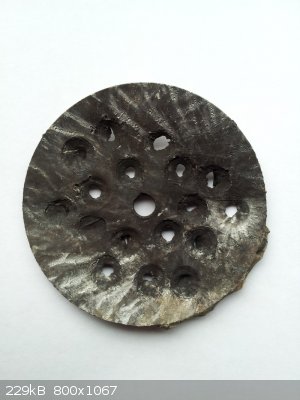
Please be careful. The time to think about safety is before the experiment begins.
http://www.sciencemadness.org/talk/viewthread.php?tid=35810
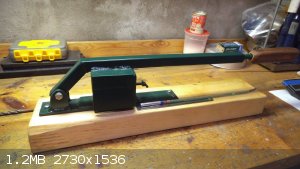
[Edited on 20-2-2015 by Bert]
Rapopart’s Rules for critical commentary:
1. Attempt to re-express your target’s position so clearly, vividly and fairly that your target says: “Thanks, I wish I’d thought of putting it
that way.”
2. List any points of agreement (especially if they are not matters of general or widespread agreement).
3. Mention anything you have learned from your target.
4. Only then are you permitted to say so much as a word of rebuttal or criticism.
Anatol Rapoport was a Russian-born American mathematical psychologist (1911-2007).
|
|
|
Tdep
National Hazard
   
Posts: 516
Registered: 31-1-2013
Location: Laser broken since Feb 2020 lol
Member Is Offline
Mood: PhD is done! It isn't good but it's over lol
|
|
Hello, I made picric acid from aspirin for the second time yesterday, the first time being a great success. This time I tried a recrystallisation in
hope of a higher product, but looking at the recrystallised substance an orange solid can be seen on the yellow crystals of picric acid. If it's not
picric acid, it must be DNP? No other contaimates were added, but I did add the picric acid to boiling hot water to recrystallise. Is that an awful
move, and with too much hot water did I reverse the final nitration of the third nitrate group? The before recrystallised substance was the usual
bright yellow when damp and pale yellow when dry.
Also, it burns super fast for picric acid, which in my experience just melts and burns with black smoke. A clip of the DNP(??) burning
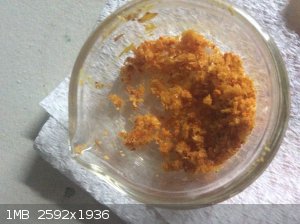
[Edited on 23-3-2015 by Tdep]
|
|
|
PHILOU Zrealone
International Hazard
    
Posts: 2893
Registered: 20-5-2002
Location: Brussel
Member Is Offline
Mood: Bis-diazo-dinitro-hydroquinonic
|
|
Third nitro won't hydrolytically reverse that easily.
If you had TNP it remains TNP.
It is possible that you have some under an isomeric form (nitronic form) that usually happens in basic media and slow acidification...this form will
be more brown/red/orange than the yellow normal one
HO-C=C(-NO2) <--> O=C-C(=N(O)-OH) (rest of the aromatic ring left aside for clarity)
PH Z (PHILOU Zrealone)
"Physic is all what never works; Chemistry is all what stinks and explodes!"-"Life that deadly disease, sexually transmitted."(W.Allen)
|
|
|
Hennig Brand
International Hazard
    
Posts: 1284
Registered: 7-6-2009
Member Is Offline
Mood: No Mood
|
|
That burn rate is not fast at all especially considering you heated the whole sample up to very near the ignition point; the part that first ignited
would only need to supply a very small amount of extra energy to adjacent material to raise its temperature the last little bit and get it to ignite.
A material that would normally progressively burn from one side of a sample to the other when lit can be seen to burn much faster, sometimes almost
instantaneously, when the whole sample is heated like this to the ignition point.
"A risk-free world is a very dull world, one from which we are apt to learn little of consequence." -Geerat Vermeij
|
|
|
PHILOU Zrealone
International Hazard
    
Posts: 2893
Registered: 20-5-2002
Location: Brussel
Member Is Offline
Mood: Bis-diazo-dinitro-hydroquinonic
|
|
Also, you cannot exclude the formation of Al(Picrate)3 and H2 evolution while heating picric acid on Aluminium foil...this may explain the erratic way
of burning...
PH Z (PHILOU Zrealone)
"Physic is all what never works; Chemistry is all what stinks and explodes!"-"Life that deadly disease, sexually transmitted."(W.Allen)
|
|
|
Hennig Brand
International Hazard
    
Posts: 1284
Registered: 7-6-2009
Member Is Offline
Mood: No Mood
|
|
I would judge that the level of nitration is lower than it should be and/or that there is a considerable amount of oxidation products in the sample.
"A risk-free world is a very dull world, one from which we are apt to learn little of consequence." -Geerat Vermeij
|
|
|
|